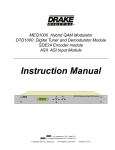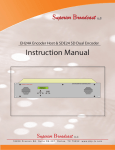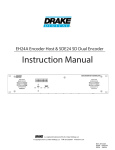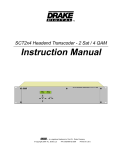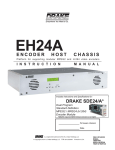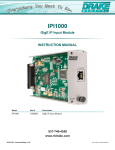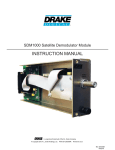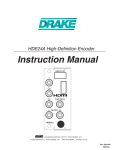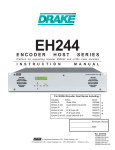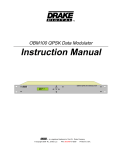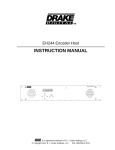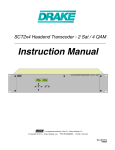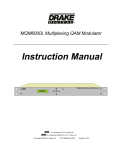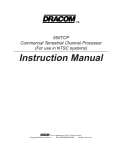Download DRAKE MEQ1000A Instruction manual
Transcript
MEQ1000A Multiplexing Hybrid QAM Modulator Instruction Manual MEQ1000A MULTIPLEXING HYBRID QAM MODULATOR QAM OUPUT 0.00 Mbits/S ENTER SELECT TM is a trademark of R.L. Drake Holdings, LLC is a registered trademark of R.L. Drake Holdings, LLC © Copyright 2013 R.L. Drake Holdings, LLC Part No. 651232700 A Printed in the U.S.A. 2 Caution Statements WARNING: TO PREVENT FIRE OR ELECTRICAL SHOCK, DO NOT EXPOSE TO RAIN OR MOISTURE CAUTION RISK OF ELECTRIC SHOCK DO NOT OPEN CAUTION: TO REDUCE THE RISK OF ELECTRIC SHOCK, DO NOT REMOVE COVER NO USER-SERVICEABLE PARTS INSIDE REFER SERVICING TO QUALIFIED PERSONNEL A product and cart combination should be moved with care. Quick stops, excessive force and uneven surfaces may cause the product and cart combination to overturn. The lightning flash with arrow head symbol, within an equilateral triangle, is intended to alert the user to the presence of uninsulated “dangerous voltage” within the product’s enclosure that may be of sufficient magnitude to constitute a risk of electric shock to persons. The exclamation point within an equilateral triangle is intended to alert the user to the presence of important operating and maintenance (servicing) instructions in the literature accompanying the product. WARNING: TO REDUCE THE RISK OF FIRE OR ELECTRIC SHOCK, DO NOT EXPOSE THIS PRODUCT TO RAIN OR MOISTURE. DO NOT OPEN THE CABINET; REFER SERVICING TO QUALIFIED PERSONNEL ONLY. CAUTION: TO PREVENT ELECTRIC SHOCK, DO NOT USE THIS (POLARIZED) PLUG WITH AN EXTENSION CORD RECEPTACLE OR OTHER OUTLET UNLESS THE BLADES CAN BE FULLY INSERTED TO PREVENT BLADE EXPOSURE. ATTENTION: POUR PREVENIR LES CHOCS ELECTRIQUES, NE PAS UTILISER CETTE FICHE POLARISEE AVEC UN PROLONGATEUR, UNE PRISE DE COURANT OU UNE AUTRE SORTIE DE COURANT, SAUF SI LES LAMES PEUVENT ETRE INSEREES A FOND SANS EN LAISSER AUCUNE PARTIE A DECOUVERT. The MEQ1000A and its associated input modules have been designed to comply with, and tested to confirm compliance to the following safety regulations: ANSI/UL 60065, 7th Edition, dated 06/30/2004, rev. 11/20/2006, CAN/CSA - C22.2 No. 60065:03 (2006). Important Safety Instructions 3 Consignes importantes de sécurité 3 1. Read Instructions—All the safety and operating Instructions should be read before the product is operated. 1a. Lire les directives -Toutes les directives de sécurité et d’utilisation devraient être lues avant de mettre l’appareil en opération. 2. Retain Instructions—The safety and operating instructions should be retained for future reference. 2a. Conserver les directives – Les directives de sécurité et d’utilisation devraient être conservées pour consultation future. 3. Heed Warnings—All warnings on the product and in the operating instructions should be adhered to. 3a. Tenir compte des avertissements –Tous les avertissements apparaissant sur l’appareil et dans les consignes d'utilisation devraient être respectés. 4. Follow instructions - All operating and use instructions should be followed. 4a. Suivre les directives - Toutes les directives d’opération et d'utilisation devraient être suivies. 5. Cleaning—Unplug this product from the wall outlet before cleaning. Do not use liquid cleaners or aerosol cleansers. Use a damp cloth for cleaning. 5a. Nettoyage – Débrancher l’appareil de la prise électrique murale avant le nettoyage. Ne pas utiliser de nettoyants liquides ou aérosols. Employer un linge humide pour le nettoyage. 6. Attachments—Do not use attachments that are not recommended by the product manufacturer as they may cause hazards. 6a. Fixation – Ne pas utiliser d’autres fixations que celles recommandées par le manufacturier; elles pourraient être source de dangers. 7. Water and Moisture—Do not use this product near water—for example, near a bathtub, wash bowl, kitchen sink or laundry tub; in a wet basement; or near a swimming pool; and the like. 7a. Eau et humidité – Ne pas utiliser cet appareil près de l’eau. Par exemple, près d'une baignoire, d’un bac de lavage, d'un évier de cuisine ou d'une cuvette de lessivage; dans un sous-sol humide; ou à proximité d'une piscine; et autres environnements similaires. 8. Accessories—Do not place this product on an unstable cart, stand, tripod, bracket, or table. The product may fall, causing serious injury to a child or adult and serious damage to the product. Use only with a cart, stand, tripod, bracket, or table recommended by the manufacturer, or sold with the product. Any mounting of the product should follow the manufacturer's instructions, and should use a mounting accessory recommended by the manufacturer. 8a. Accessoires – Ne pas installer cet appareil sur un chariot, un socle, un trépied, un support ou une table instables. L’appareil pourrait tomber, entraînant des blessures graves à un enfant ou à un adulte, et des dommages importants à l’appareil. Employer seulement avec un chariot, un socle, un trépied, un support, ou une table recommandés par le fabricant ou vendu avec l’appareil. Toute installation de l’appareil devrait être conforme aux directives du manufacturier et devrait utiliser des accessoires d’installation recommandés par celui-ci. 9. A product and cart combination should be moved with care. Quick stops, excessive force, and uneven surfaces may cause the product and cart combination to overturn. 9a. Un chariot supportant l’appareil devrait être déplacé avec précaution. Les arrêts brusques, la force excessive et les surfaces inégales peuvent renverser le chariot. 10. Ventilation—Slots and openings in the cabinet are provided for ventilation and to ensure reliable operation of the product and to protect it from overheating, and these openings must not be blocked or covered. The openings should never be blocked by placing the product on a bed, sofa, rug, or similar surface. This product should not be placed in a built-in installation such as bookcase or rack unless proper ventilation is provided or the manufacturer's instructions have been adhered to. 10a. Ventilation – Des fentes et ouvertures dans le châssis sont prévues pour la ventilation de l’appareil, pour en assurer la fiabilité d’opération et le protéger contre la surchauffe. Ces ouvertures ne doivent pas être bloquées ou recouvertes. Ces ouvertures ne devraient jamais être bloquées en plaçant l’appareil sur un lit, un sofa, une couverture, ou une surface semblable. Cet appareil ne devrait pas être installé dans un meuble encastré comme une bibliothèque ou une étagère à moins de lui fournir une ventilation adéquate ou que l’installation soit conforme aux directives du manufacturier. 11. Power Sources—This product should be operated only from the type of power source indicated on the marking label. If you are not sure of the type of power supplied to your home, consult your product dealer or local power company. For products intended to operate from battery power, or other sources, refer to the operating instructions. 11a. Sources d’alimentation électrique - Cet appareil devrait être utilisé seulement avec le type d’alimentation électrique inscrite sur l’étiquette. Si vous n'êtes pas certain du type d’alimentation électrique fourni à votre maison, consultez le vendeur de l’appareil ou l’entreprises d'énergie locale. Pour des appareils alimentés par une batterie ou d'autres sources, se référer aux consignes d'utilisation. 12. Grounding or Polarization—This product may be equipped with a polarized alternating-current line plug (a plug having one blade wider than the other) This plug will fit into the power outlet only one way. This is a safety feature. If you are unable to insert the plug fully into the outlet, try reversing the plug. If the plug should still fail to fit, contact your electrician to replace your obsolete outlet. Do not defeat the safety purpose of the polarized plug. Alternate Warnings—If this product is equipped with a three-wire grounding-type plug, a plug having a third (grounding) pin, the plug will only fit into a groundingtype power outlet. This is a safety feature. If you are unable to insert the plug into the outlet, contact your electrician to replace your obsolete outlet. Do not defeat the safety purpose of the grounding-type plug. 12a. Mise à la terre ou polarisation - Cet appareil peut être équipé d'une fiche électrique de courant alternatif polarisée (une fiche ayant une lame plus large que l'autre). Cette fiche ne s’insérera correctement dans la prise de courant que d’une seule façon; c'est un dispositif de sécurité. S’il est impossible d’insérer la fiche entièrement dans la prise de courant, essayer de renverser la fiche. Si la fiche ne s’insère toujours pas, contacter un électricien pour remplacer la prise de courant désuète. Ne pas altérer le dispositif de sécurité de la fiche polarisée. Mise en garde supplémentaire - Si cet appareil est équipé d'une fiche électrique à trois broches (une fiche ayant une broche de mise à la terre), la fiche s'insérera seulement dans une prise de courant équipée d’une mise à la terre; c'est un dispositif de sécurité. S’il est impossible d’insérer la fiche dans la prise de courant, contacter un électricien pour remplacer la prise de courant désuète. Ne pas altérer le dispositif de sécurité de la fiche avec mise à la terre. 13. Power-Cord Protection—Power-supply cords should be routed so that they are not likely to be walked on or pinched by items placed upon or against them, paying particular attention to cords at plugs, convenience receptacles, and the point where they exit from the product. 13a. Protection du cordon d’alimentation - Les cordons d’alimentation devraient être disposés de façon à ce qu’on ne puisse marcher dessus ou qu’ils soient susceptibles d’être coincés par des articles placés sur ou contre eux. Une attention particulière doit être portée aux fiches, prises de courant, et aux points où ils sortent de l’appareil. 14. Outdoor Antenna Grounding—If an outside antenna or cable system Is connected to the product, be sure the antenna or cable system is grounded so as to provide some protection against voltage surges and built-up static charges. Article 810 of the National Electrical Code, ANSI/NFPA 70, provides information with regard to proper grounding of the mast and supporting structure, grounding of the lead-in wire to an antenna discharge unit, size of grounding conductors, location of antenna-discharge unit, connection to grounding electrodes, and requirements for the grounding electrode. See Figure A. 14a. Mise à la terre de l’antenne extérieure - Si un système extérieur d'antenne ou de câble est relié à l’appareil, s’assurer que le système d'antenne ou de câble est muni d’une mise à la terre afin de fournir une certaine protection contre les surtensions et les charges d’électricité statique. L'article 810 du code électrique national, ANSI/NFPA 70, fournit l'information nécessaire en ce qui concerne la mise à la terre appropriée du mât et de la structure porteuse, la mise à la terre du câble de connexion à une unité de décharge d’antenne, le calibre des conducteurs de mise à la terre, la location de l’unité de décharge d’antenne, le raccordement aux électrodes de mise à la terre et les spécifications pour les électrodes de mise à la terre. Voir la figure A. 15. Lightning—For added protection for this product during a lightning storm, or when it is left unattended and unused for long periods of time, unplug It from the wall outlet and disconnect the antenna or cable system. This will prevent damage to the product due to lightning and power-line surges. 15a. Foudre - Pour une protection supplémentaire de cet appareil pendant un orage électrique, ou quand il est laissé sans surveillance et inutilisé pendant de longues périodes, le débrancher de la prise électrique murale et déconnecter le système d'antenne ou de câble. Ceci préviendra les dommages à l’appareil dus à la foudre et aux surtensions. 16. Power Lines—An outside antenna system should not be located in the vicinity of overhead power lines, other electric light or power circuits, where it can fall into such power lines or circuits. When installing an outside antenna system, extreme care should be taken to keep from touching such power lines or circuits as contact with them may be fatal. 16a. Lignes électriques - Un système d'antenne extérieur ne devrait pas être situé à proximité de lignes électriques aériennes ou de tout autre circuit électrique, où il pourrait tomber sur de tels circuits ou lignes électriques. Lors de l’installation d’un système d’antenne extérieur, d’extrêmes précautions devraient être prises afin de prévenir tout contact avec des lignes ou circuits électriques. Entrer en contact avec de tels circuits ou lignes électriques pourrait être fatal. 17. Overloading—Do not overload wall outlets, extension cords, or integral convenience receptacles as this can result in a risk of fire or electric shock. 17a. Surcharge – Ne pas surcharger les prises de courant murales, les rallonges électriques ou les prises de courant intégrées. Un risque d’incendie ou de choc électrique pourrait résulter d’une telle surcharge. 4 4 Important Safety Instructions (cont.) Consignes importantes de sécurité 18. Object and Liquid Entry—Never push objects of any kind into this product through openings as they may touch dangerous voltage points or short-out parts that could result in a fire or electric shock. Never spill liquid of any kind on the product. 18a. Insertion d’objet ou de liquide – Ne jamais insérer d’objet par les ouvertures de cet appareil. Il pourrait toucher des points de voltage dangereux ou court-circuiter des pièces, ce qui pourrait résulter en incendie ou en choc électrique. Ne jamais verser de liquide sur l’appareil. 19. Servicing—Do not attempt to service this product yourself as opening or removing covers may expose you to dangerous voltage or other hazards. Refer all servicing to qualified service personnel. 19a. Entretien –Ne pas essayer de faire soi-même l’entretien de cet appareil. En ouvrir ou en retirer les couvercles pourrait vous exposer à des voltages dangereux ou à d’autres dangers. Confier tout entretien à un personnel de service qualifié. 20. Damage Requiring Service—Unplug this product from the wall outlet and refer servicing to qualified service personnel under the following conditions: a. When the power-supply cord or plug is damaged, b. If liquid has been spilled, or objects have fallen into the product, c. If the product has been exposed to rain or water, d. If the product does not operate normally by following the operating instructions. Adjust only those controls that are covered by the operating instructions as an improper adjustment of other controls may result in damage and will often require extensive work by a qualified technician to restore the product to its normal operation, e. If the product has been dropped or damaged in anyway, and f. When the product exhibits a distinct change in performance—this indicates a need for service. 20a. Dommage exigeant un entretien - Débrancher cet appareil de la prise de courant électrique et confier l'entretien au personnel de service qualifié dans les éventualités suivantes: a. Quand le cordon d’alimentation ou sa fiche sont endommagés, b. Si des objets sont tombés dans l’appareil, ou si du liquide y a été renversé, c. Si l’appareil a été exposé à la pluie ou à l'eau, d. Si l’appareil ne fonctionne pas normalement en suivant les consignes d'utilisation. Ajuster seulement les commandes qui sont mentionnées dans le guide d'opération. Un mauvais ajustement des autres commandes pourrait causer des dommages à l’appareil et souvent exiger un travail supplémentaire de la part d’un technicien qualifié pour remettre l’appareil en état normal d’opération. e. Si l’appareil a été échappé ou endommagé de n’importe quelle façon, et f. Quand l’appareil montre un changement notable de performance – ceci indique qu’un entretien est nécessaire. 21. Replacement Parts—When replacement parts are required, be sure the service technician has used replacement parts specified by the manufacturer or have the same characteristics as the original part. Unauthorized substitutes may result in fire, electric shock or other hazards. 21a. Pièces de rechange - Si des pièces de rechange sont nécessaires, s’assurer que le technicien de service a employé des pièces de rechange spécifiques du manufacturier ou ayant les mêmes caractéristiques que les pièces originales. L’utilisation de pièces de rechange non autorisées pourrait résulter en incendie, choc électrique ou autres dangers. 22. Safety Check—Upon completion of any service or repairs to this product, ask the service technician to perform safety checks to determine that the product is in proper operating condition. 22a. Vérification de sécurité – À la suite de toute réparation ou entretien de cet appareil, demander au technicien de service d'exécuter des vérifications de sécurité afin de s’assurer que l’appareil est en condition normale de fonctionnement. 23. Wall or Ceiling Mounting—The product should be mounted to a wall or ceiling only as recommended by the manufacturer. 23a. Montage au mur ou au plafond - L’appareil ne devrait être monté au mur ou au plafond qu’uniquement de la façon recommandée par le manufacturier. 24. Heat—The product should be situated away from heat sources such as radiators, heat registers, stoves, or other products (including amplifiers) that produce heat. 24a. Chaleur – L’appareil devrait être situé loin de sources de chaleur telles que des radiateurs, des registres de chaleur, des fourneaux, ou d'autres appareils (y compris amplificateurs) produisant de la chaleur. Figure A Example of antenna grounding as per National Electrical Code, ANSI/NFPA 70 Exemple de mise à la terre d’antenne selon le code électrique national, ANSI/NFPA 70 NOTE TO CATV SYSTEM INSTALLERS: THIS REMINDER IS PROVIDEO TO CALL THE CATV SYSTEM INSTALLER'S ATTENTION TO ARTICLE 820 - 40 OF THE NEC THAT PROVIDES GUIDELINES FOR PROPER GROUNDING AND, IN PARTICULAR, SPECIFIES THAT THE CABLE GROUND SHALL BE C0NNECTED TO THE GROUNDING SYSTEM OF THE BUILDING, AS CLOSE TO THE POINT OF CABLE ENTRY AS PRACTICAL. NOTE AUX INSTALLATEURS DE SYSTÈME DE CATV : CE RAPPEL EST FOURNI POUR PORTER À L’ATTENTION DES INSTALLATEURS DE SYSTÈME DE CATV, L'ARTICLE 820 - 40 DU NEC QUI DONNE DES DIRECTIVES POUR UNE MISE À LA TERRE APPROPRIÉE ET, EN PARTICULIER, SPÉCIFIE QUE LE CÂBLE DE MISE À LA TERRE DEVRAIT ÊTRE RACCORDÉ AU SYSTÈME DE MISE À LA TERRE DU BÂTIMENT LE PLUS PRÈS POSSIBLE DE L’ENTRÉE DU CÂBLE. ANTENNA LEAD IN WIRE CÂBLE DE CONNEXION DE L’ANTENNE GROUND CLAMP ANTENNA DISCHARGE UNIT (NEC SECTION 810-20) UNITÉ DE DÉCHARCHE D’ANTENNE ELECTRIC SERVICE EQUIPMENT NEC - NATIONAL ELECTRIC CODE NEC – CODE ÉLECTRIQUE NATIONAL GROUNDING CONDUCTORS (NEC SECTION 810-21) CONDUCTEURS DE MISE À LA TERRE GROUND CLAMPS ATTACHES DE MISE À LA TERRE POWER SERVICE GROUNDING ELECTRODE SYSTEM (NEC ART 250. PART H) SYSTÈME DE MISE À LA TERRE DU BÂTIMENT Table of Contents / TABLE OF CONTENTS 2 Caution Statements 3 Important Safety Instructions 5 6 General Description 7 Installation and Mounting / Front Panel Controls 8 Rear Panel Controls and Connections 9 Setup and Programming / Software Flow Chart 12 Setup and Programing (Continued) / Operation 13 14 16 17 18 19 Operating Instructions for Drake Digital Headend Program DTA/EAS Considerations and Additional Information CATV Channel Frequencies Broadcast TV Channel Frequencies Service / If You Need To Call For Help Warranty SPECIFICATIONS MEQ1000A Modulation Modes: Symbol Rate: FEC: I/Q Phase Error: Carrier Suppression: Channel Amplitude Error: MER: MEQ1000A Output Frequency Range: Channel Plan: Frequency Stability: Maximum Output Level: Minimum Output Level: Output Level Accuracy: Output Impedance: Spurious Outputs: Broadband Noise: Phase Noise: MEQ1000A Data Link: RS232 Input: RS232 Output: MEQ1000A MEQ1000A Power: Weight: Size: Operating Temperature: QAM Modulator 16QAM, 32QAM, 64QAM, 128QAM, 256QAM, 512QAM, or 1024QAM. 1 Ms/s to 7 Ms/s. ITUA (DVB) or ITUB (Digitcipher). Less than 1 degree. 45 dB. Less than 1 dB. Greater than 38 dB with blind equalizer. Upconverter RF Output 54 MHz to 1002 MHz. Standard CATV, HRC, IRC, or Broadcast. ± 5 ppm. + 61 dBmV minimum, adjustable downward. + 45 dBmV. ± 1 dB. 75 Ohms with return loss better than 14 dB (within output filter passband). -60 dBc from 40 MHz to 1000 MHz. Less than -12 dBmV (6 MHz BW @ ± 12 MHz). -101 dBc @ 10 kHz offset. RS232 Control 2400, 4800, 9600, or 19,200 baud interface via serial cable. DB-9 connector for connection to modem or PC. DB-9 connector for connection to other transcoders. ASI Output The ASI output provides a copy of the transport stream that is input to the QAM modulator. General 90 - 132 VAC/60 Hz, 35 W maximum. 9.5 pounds. 19” W x 1.75” H x 14.5” D. 0 degrees C to + 50 degrees C. 5 6 General Description MEQ1000A MULTIPLEXING HYBRID QAM MODULATOR QAM OUTPUT 0.000 Mbits/S GENERAL DESCRIPTION The R.L. Drake model MEQ1000A is a commercial grade hybrid QAM modulator. The MEQ1000A features plug-in input modules that include an ATSC/QAM tuner, an ASI input, an SDI/HD-SDI input, HDMI (non-HDCP), Composite input, Component input, and analog NTSC inputs; thus the description 'hybrid' is used to describe it. A multiplexer is built in to combine the transport streams and input the filtered and groomed transport stream to the QAM modulator. This manual includes feature examples utilizing the Drake DTD1000 Digital Tuner and Demodulator Module, and the ASII ASI-Input Module. Other available input modules include: SDE24 Dual SD MPEG Encoder HDE24 High Definiton MPEG Encoder SDI24A SDI/HD-SDI Input Encoder SDE24EAS Emergency Alert System Encoder The MEQ1000A has two input module slots and the outputs interface to the MEQ1000A multiplexer, internally, where they are MPEG program filtered, multiplexed, and groomed. Programs, among the total group from input module A and input module B, may be selected or not selected by the operator to be sent to the QAM modulator. Each input must contain no more than 20 programs and a maximum of 20 programs per input may be selected. Also, the total bitrate of the selected programs must not exceed that of the output QAM channel capacity. modulated signal. It may be used to convert one off-air ATSC 8VSB signal to a QAM output with rate adjustment. Used in the processor mode with only one input, the DQT1000 can process ATSC or CATV QAM inputs. No multiplexing or altering of any MPEG tables is performed in this mode. Used in the non-multiplexing mode, the data rate of the incoming signal can be any rate that falls within the specification range. The output rate can be set to any fixed output rate (equal to or faster than the input rate). MULTIPLEXING TWO ATSC TRANSPORT STREAMS Utilizing two DTD1000 input modules, two off-air 19.4 Mbps ATSC signals (QAM modulated CATV delivered signals could also be used) can be received and multiplexed to obtain a 38.8 Mbps 256QAM output. Thus two ATSC inputs can be output on a single 6 MHz bandwidth 256 QAM channel. Another way of combining two ATSC 19.4 Mbps streams is to receive the first stream using the 8VSB input (DTD1000) and input the second stream, if available in ASI format, through the ASII module in the second input slot. Again the two combined ATSC signals will be modulated at 256QAM in a 6 MHz wide channel. If it is desired to provide both ATSC signals from two ASI sources, two ASII modules can be used. When the MEQ1000A is used as described above, no loss of picture or sound packets occurs. There is no added compression of the video or audio streams. Only the necessary control packets are rewritten to prevent duplication of MPEG2 program numbers and major and minor channel number assignments in the tables. Some common applications include: Channel Drop/Add, cherry picking programs from ASI MPTS inputs, digital channel processing, or local origination additions. Using a PC interface, the operator can select the major and minor program numbers that he desires for each program in the output multiplex. The MEQ1000A contains a high performance QAM modulator that can operate in most ITU-A or ITU-B modes up through 1024QAM. The very low noise, high output, upconverter provides coverage from 54 MHz to 1002 MHz while maintaining exceptionally low phase noise and broadband noise. Output level can be selected at a value between + 45 dBmV and + 61 dBmV. PROGRAM FILTERING A 'Select Program' function is provided to allow the operator to select which of the MPEG programs present on the A and B input streams are to be included in the output multiplex. The MEQ1000A operates in a fixed output clock mode and processes null packets when required to maintain the set fixed clock rate. PCR correction is included. DIGITAL CHANNEL PROCESSING (One input module) The DTD1000 input module tunes any 8-VSB or QAM channel between 54 MHz and 1002 MHz. It is ideal for digital 'channel processing' applications where a single digital video signal is received, error corrected, clocked at a user determined fixed rate and remodulated on the same or another RF channel. Applications include cleaning up a low MER QAM signal received from a CATV source or fiber link receiver, or shifting the RF frequency of a QAM PSIP OPTIONS When operating in the multiplex mode, the MEQ1000A can be set to process PSIP information from both sources and rewrite tables containing combined PSIP information, or in cases where the offair broadcast channels may not be transmitting some or all of the tables, it can be set to ignore and discard the PSIP tables completely, or it can be set to generate MGT and VCT tables without EIT tables. Null packet processing is applied as necessary to keep the output data rate at the desired setting. PCR correction is provided. The operator can program desired major and minor channel numbers for each program in the output stream. OUTPUTS - RF and ASI The 54 to 1000 MHz RF output is always QAM regardless of whether the input is VSB or QAM. This same filtered stream is also output via the rear panel ASI output jack. Installation & Mounting / Front Panel Controls 7 INSTALLATION AND MOUNTING NOTES This equipment is designed to be installed in a standard 19” rack. A built in fan provides air movement through the unit. When connecting an incoming RF signal source to two DTD1000 modules, note that the antenna or CATV source must be connected to both the A and B input connectors. These inputs are kept separate in case the inputs need to come from different antennas or one antenna and one CATV source. Connect the AC line cord to an appropriate source of 120 volt, 50/60 Hz AC power. The MEQ1000A is always on once the AC power cord is connected to its power source. F1 F2 F5 F6 F7 F8 MEQ1000A MULTIPLEXING HYBRID QAM MODULATOR ENTER QAM OUTPUT 0.000 Mbits/S F3 SELECT F4 F1, LCD Display – This display presents the selected menu screen and the parameter settings. The backlight in the display is on when power is applied. During operation, the S/N (signal to noise ratios) of the demodulator input signals are displayed. For 8VSB inputs, the threshold is about 15 dB. For QAM inputs, the threshold is about 23 dB for 64QAM and 27 dB for 256QAM. You should maintain a S/N several dB above these thresholds for reliable operation. F2, ENTER Button – Use the ENTER button to enter the adjust mode or to save and load a new setting or settings after adjustment. Hold for 2 seconds until the bottom line of the display starts to flash to enter the adjust mode. After entering the adjust mode, momentarily pressing the ENTER button again will load and save any settings that may have been changed using the F5 & F6 buttons. F3 & F4, ◄ (Left) and ► (Right) Buttons – Use the left and right arrow buttons to navigate from screen to screen to view a parameter setting. These buttons are operational in the view mode or the adjust mode. Using only these buttons will not change any parameter settings. After a short period of button inactivity, the default display will be returned. F5 & F6, ▲ (Up) and ▼ (Down) Buttons – Use the down and up arrow buttons to change the value of a viewed parameter setting. The unit must be in the adjust mode with the display flashing in order for these buttons to become active for changing a parameter setting. If the unit is not in the adjust mode, pressing the up button will display the firmware version number or pressing the down button will display the output QAM symbol rate. F7 & F8, ◄ Select ► Buttons - Use the left or right Select arrow buttons to select which section of the unit to control. Select one of the input modules or the QAM modulator / up converter section. 8 Rear Panel Connections R1 R2 R3 R4 R5 R6 R7 R8 R9 MEQ1000A - This illustration shows the rear of the MEQ1000A. The ASI connectors are type BNC female. The ASI input is used to input SCTE-18 data in ASI format for use with DTAs and in EAS daisy-chaining applications. R1; RF OUTPUT – This is the high level (61 dBmV), 54 to 1002 MHz, output from the MEQ1000A upconverter section. R2; Contact Closure Terminal - Connect these to EAS Receiver Contact Closure cables to allow the triggering of EAS activation. R3; ASI Input - This is for receiving EAS and DTA data from a Drake EH24, EH24A, EH244, EH244-IP or MEQ1000A. R4; Input Module Slot A. R5; Input Module Slot B. R6; ASI Output - This output delivers the same multi-program transport stream in ASI as is sent to the QAM modulator. When the DTA/EAS mode is Enabled, this ASI output no longer outputs the same data as the QAM output; it now acts as an ASI Loop, outputting DTA/EAS data only. R7; RS232 in - Connection to a PC or modem for use with remote control / monitoring program or for firmware update download. R8; RS232 OUT - Loop/Daisychain to another MEQ1000A. R9; AC Line Cord – For connection to the nominal 120 VAC power source. This unit is designed for use in countries with 120 VAC power standards but the power supply will accept an input voltage range of 90 VAC minimum to 260 VAC maximum with a power line frequency of either 50 or 60 Hz. Setup and Programming / Software Flow Chart 9 Programming and viewing of the various setup and operating parameters is accomplished using the front panel back lit, two line, sixteen character wide LCD along with the two LEFT and RIGHT SELECT buttons and the five LEFT, RIGHT, UP, DOWN and ENTER buttons. The name of the parameter is on the top line of the display and the setting value is on the bottom line. To observe a certain parameter setting without intending to change its value, just use the LEFT and RIGHT SELECT buttons and the LEFT and RIGHT arrow buttons to navigate through the menus shown in the software flow chart below. The current setting for each parameter is shown on the bottom line of the display. Note that depending upon certain settings, some screens are not needed and will be skipped. To make a change in the displayed parameter and its setting and if this is the initial setup, you will want to enter the ‘adjust’ mode. To do this, press the ENTER button that is located in the center of the four arrow buttons and hold in for several seconds until the display begins to flash. After you are in the adjust mode (bottom line of screen flashing) use the left and right arrows to navigate among screens and use the up and down arrows to change the parameter setting. When ENTER is pressed, the new settings will be loaded and stored and the unit will exit the ‘adjust’ mode. You may wish to not press ENTER until you have gone through all screens and settings and then press ENTER to save and load all changes in one step OR you can store just one or several parameters at a time and reenter adjust mode to set the next. Either method is acceptable. 10 Setup and Programming (Continued) This section provides additional details regarding the selectable items shown in the ‘adjust’ mode on the Software Flow Chart on page 8. Choose the SELECT PROGRAMS setting to allow the operator to pick which programs from the A and B inputs are to be included in the output multiplex. SETUP: MEQ1000 (For Specific EAS and DTA Settings, Refer to Page 14) NOTE: At this point you may proceed through the remaining menus, below, before pressing the ENTER button to load the selected data OR you may press ENTER now and then come back to the rest of the menus. In any case, when the ENTER button is pressed, one of the following two actions will occur: UNIT ID: Select the desired unit identification number when connecting the 'RS232 IN' connector to a PC or modem for remote control using 'Drake Remote Control Software'. Numbers 1 thru 63 may be used. If zero (0) is selected, the PC will ignore the unit. RS232 BAUD RATE: This setting determines the baud rate at which the MEQ1000 communicates with the remote PC. Settings available are 2400, 4800, 9600 and 19,200. All units 'daisy chained' to the remote PC or modem must be set to the same baud rate. MULTIPLEX: This setting determines whether the Input Module Slot A input is to be multiplexed with a second input (if installed). Select Input Module Slot A to activate the A Input Module only. Select Input Module Slot B to activate the B input module only. To turn on the multiplex function select ENABLED. If either A or B Input module is selected, the next menu will be the QAM MODE menu. You may skip to that paragraph, below. INPUT B OFFSET: When the Input Module Slot B or ASI input has been installed and selected in the MULTIPLEX menu, this menu will be present. Because the two incoming transport streams are likely to have overlapping use of MPEG program numbers, the MEQ1000 will pass the program numbers from input A unchanged and an offset, equal to the value chosen in this menu, will be added to the program number of programs from the second input. This same offset value will also be added to the minor channel number in the VCT table for programs from the second input source. Usually an offset of 10 will be adequate but if you know there are programs in the signal input to input A using program numbers above 10, a higher offset may be required. Values between 10 and 90, in increments of 10, are available for selection. When it is known that there is no overlap between input A and input B stream program numbers, a 0 offset setting can be used. Be cautious if this is the selection that is chosen. MPEG PROGRAMS: This menu provides selections to determine which programs are multiplexed to form the new multiprogram transport stream output that will be supplied to the QAM modulator section. Choose the SELECT ALL PROGS setting to multiplex all programs from inputs A and B up to 20 programs maximum. If more than 20 exist, you must use SELECT PROGRAMS and only select 20 maximum. It is the operator's responsibility to be sure that the total data rate of these programs does not exceed the maximum data rate for the output QAM mode that will be used, typically 26.98 Mbps for 64QAM or 38.8 Mbps for 256QAM in ITUB modes. If the sum of input bitrates would exceed this amount, or if more than 20 programs are present, some programs will have to be dropped from the list of selected programs. A) If SELECT ALL PROGS has been selected, the MEQ1000A will now read PAT tables from the two input streams and discover which MPEG programs are defined. If you wish to view the MPEG program numbers of programs that were found, follow the procedure below: VIEWING MPEG PROGRAM NUMBERS In order to see the MPEG program numbers of incoming streams, the following procedure can be followed: 1) Press the ENTER button for 2 seconds to enter program mode. Release button. Display will be flashing. 2) Press the ENTER key again and hold. By continuing to hold in the ENTER button, the following display will be slowed down so that program numbers can be read as they scroll by. 3) A screen will be displayed that indicates: PMT PROG A xxxx or PMT PROG B xxxx. 4) The xxxx field will be a number that corresponds to the MPEG program number of a program found in the PMT table for the indicated (A or B) input. As the button is held, all entries for input A will scroll past and then entries for input B will scroll past. 5) Release button and if necessary repeat steps 1 - 4. B) If SELECT PROGRAMS was chosen, the unit will read the PAT tables from both inputs and then display: MPEG PROG XXXXX: (XXXXX is a number from 00001 to 65535) on the top line of the display. Using the right and left arrow keys, you can scroll through all 65535 possible program numbers. Don't be alarmed by the large number of possibilities because if the arrow key is held down, the scrolling will speed up so all 65535 possible numbers can be scanned in a short time - any time an entry is found at a given program number, the scrolling will slow down to give the operator time to see it and stop scrolling, if desired. Usually, all programs are known to be numbered between 01 and 20. For each MPEG program number, displayed on the top line, the bottom line, on the right, will indicate A, B, AB, or nothing. This will indicate that the program number on the top line was found in input A or B or AB for both or not in either one if blank. To select programs to be included in the output multiplex, use the up and down arrow keys to select NOT SELECTED, INPUT A, INPUT B, or INPUT A+B. If NOT SELECTED is used, then this program number will not be present in the output and any programs with this program number that are present in the A or B inputs will be filtered out. If INPUT A is selected, the A input program only is used. Setup and Programming (Continued) 11 If INPUT B is selected, the B program is used and A filtered out. If INPUT A+B is chosen, then both are accepted if present. Note: It is OK to use this menu to set up desired program selections 'off line'. That is, with no actual input at the present time. Programs may be selected that may not currently be in the input stream but are desired at some future time. Note: It is possible to select both programs with the same program number - one from A and one from B as long as the INPUT B offset is set so that the B program number plus the offset amount does not duplicate a program number from the A input. The offset is not included in the MPEG program number display being discussed above but the offset will be added to all MPEG program numbers from the B input when they are added to the output multiplex. PSIP: This menu provides a choice of how the unit organizes the PSIP information from two ATSC streams that are being multiplexed. In the ENABLED setting, information from the MGT and VCT tables from both signals will be used to build a new table for the combined output signal. Both input streams must have these tables present in order for the unit to be able to perform this operation. EIT tables will be processed so as to provide program information, if present, for the next 12 hours. This selection is the only one that passes EIT table program information to the multiplexed output signal. RRT and STT tables from Demod A are passed through. If the broadcast station is not transmitting complete MGT and VCT tables, the ENABLED selection cannot be used. In this situation, DISABLED may be selected. In DISABLED mode, the unit does not process or output any MGT, VCT, or EIT tables. This can be a fine solution for cable systems that use set top boxes which operate from their own system channel map and have no need for these tables. MPEG program information is still processed. Some retail consumer QAM set tops operate perfectly in this mode and others may not. The third option is the BASIC MGT, VCT choice. When this selection is made, the DQT1000 or MQM1000 will build its own MGT and VCT tables from the incoming streams even if one or both of the streams do not contain these tables. This solution should satisfy all types of set top boxes but will not provide any EIT table program guide information. The STT and RRT tables from the source are passed through unchanged in the ENABLED mode and filtered out in the other modes. VCT TABLE: This menu is only available when ENABLED or BASIC MGT, VCT has been selected in the previous PSIP menu. You may select the TVCT - TV channel table or CVCT table for CATV. Usually the TVCT choice must be selected for ATSC input signals. MAJOR CHANNEL: This menu is not available if PSIP is disabled. This setting will determine how a channel number is displayed on a consumer TV if the TV is tuning the output of the MEQ1000A without a cable box. When ORIGINAL is selected, the major channel number indicated in the output tables will be that sent by the original broadcaster. If OUTPUT CHANNEL is selected, the major channel number will be set to the channel number of the MEQ1000A RF output channel. When a cable box is used, it usually does not require or use this information. Minor channel numbers are the same as those input via module A and as input via module B with the offset added to the B side programs. When USER DEFINED is selected and the remote control software is used to allow programming via a PC, then the MPEG program number and the major and minor virtual channel numbers may be set to whatever number the operator chooses providing total flexibility. These numbers cannot be programmed with the front panel buttons but only via a PC and the RS232 interface of the MEQ1000A. It is up to the operator to insure that no duplications are made when using this mode. QAM MODE: This menu allows the user to set the modulation type for the output. Choices range from 16-QAM through 256-QAM. 'A' suffixes indicate DVB compliant FEC and the 'B' suffixes indicate DigiCipher II FEC encoding. Note that when using the MEQ1000A in the multiplex mode, the output QAM mode usually must be 256-QAM. For CATV systems using DigiCipher II, select the QAM-256B mode. For DISH Network QAM distribution or other DVB systems using DVB set tops, choose the QAM-256A mode. When used for a single input processing function, choose the output mode accordingly from any of the available options that will provide a high enough data rate. GRAY ENCODING: This menu is only available when QAM modes QAM-16A through QAM-1024A, are selected. The choices are DVB and DAVIC. Gray Encoding is normally not used for video data. QAM SYMRATE: Preset or Manual: If PRESET is selected, the symbol rate will be automatically set to the ‘normal’ rate based on the QAM mode that is selected and assuming a 6 MHz wide QAM channel. If MANUAL is selected, pressing the right or left arrow buttons will allow selection of symrates from 1.000 thru 7.000 MSym/Sec using the up and down arrow buttons. QAM SYMRATE: This menu allows selection of the output QAM baudrate or symbol rate. Set as required by the set top box. When multiplexing two ATSC input signals, in DigiCipher II, 256-QAM CATV systems, this is usually 5.3606 Ms/s. In DVB systems, the rate would be 5.264 Ms/s. In any case, the rate must be high enough to provide a data bitrate of at least 38.81 Mbps (do not confuse this with the symbol rate). If the set top box requires a fixed higher rate, this may be manually set. 12 Setup and Programming (Continued) / Operation INTERLEAVER: Sets the QAM modulator interleaver. Choose among the available selections based upon your system / set top box requirements. For typical 256-QAM. DigiCipher II CATV systems, I128, J1 is the most commonly used interleave setting but many other choices are available. This menu does not appear in the adjust mode if the QAM mode is A (DVB) as there is only one choice in the DVB standard. When not in adjust mode, this screen will display the setting in QAM - A modes as well. OUTPUT FORMAT: For normal operation, select NORMAL. For system level set up, choose CW to provide a CW carrier at the center frequency of the output channel for use in leveling a system when a QAM power meter is not available. To disable all RF output, select STANDBY. In the CW mode, the CW carrier can be measured on a spectrum analyzer without a need to apply a bandwidth correction or it can be measured with an analog meter tuned to channel center. The CW power measured will equal the channel QAM power when the modulator is returned to NORMAL output mode. Usually QAM signals are set 5 dB to 10 dB below analog NTSC channels when balancing a system. The PRBS modes provide a pseudo random binary sequence output test signal for use in laboratory testing. OUTPUT CHANMAP, OUTPUT CHANNEL: Select the desired EIA CATV channel output using these two menus. RF OUT: Select the desired RF output signal level. The available range is between 45 dBmV and 62 dBmV, selectable in 0.5 dB steps. The output accuracy is ± 1 dB. SETUP: SDE24 SELECT: The LEFT and RIGHT buttons allow the user to scroll through the encoder numbers for each encoder installed in the MEQ1000A as well as the MEQ1000A itself. Use the LEFT and RIGHT buttons to select the encoder to be programmed. OPERATION - MULTIPLEXING TWO ATSC INPUTS To use the DTD1000, SDE24 and/or the ASII modules to multiplex two ATSC inputs, proceed as follows: 1) Connect the off-air antenna, CATV feed, or audio and video (SDE24) or ASI feed, to the INPUT A and INPUT B inputs of the MEQ1000A. If using two RF inputs the two input connectors are available in case the two RF signals must come from different antennas or if one signal is coming from a cable system, etc. If using a common antenna, use a good quality two way splitter to split the antenna and feed each input. 2) Plug the power cord from the unit into the power source. 3) Follow the instructions in the programming section above to set the channel map and channel number for both INPUT MODULE A and INPUT MODULE B. 4) Set the QAM SYMRATE to PRESET. 5) Set the MULTIPLEX setting ENABLED 6) Set the INPUT B OFFSET to 10. Read details in programming section to determine if you need another value. 7) Select the desired MPEG programs. (See the previous section for details.) 8) In the PSIP menu, select BASIC MGT VCT for now, this may be changed later. See programming section for detail. 9) In the VCT TABLE menu, select TVCT. 10) In the MAJOR CHANNEL menu, select OUTPUT CHANNEL. This may be changed later. 11) From the QAM MODE menu, set the QAM modulator to QAM-256B for use in a DigiCipher II environment. If DVB, use QAM-256A instead. VIDEO: This menu entry allows the user to select between SVIDEO and COMPOSITE video input for each selected encoder. FORMAT: Either MPEG2 or MPEG4 H.264 may be selected as the output format for the selected encoder using this menu item. Encoder 2 on a given SDE24 has no option. It is forced to MPEG2. RESOLUTION: The resolution of the video output of each encoder may be selected from this menu item. The choices range from 720 x 480 thru 353 x 240 as shown on the software flow chart on page 9. BRIGHTNESS, CONTRAST, SATURATION and HUE: These menu items allow the user to assign each of these parameters of the output video values from 0 to 255. MAX AUDIO IN: This menu entry allows the user to set the maximum audio input which may be input to the selected encoder. The choices are 1 Vrms or 2 V rms. AUDIO GAIN: The audio output level can be chosen from this menu item by selection of the appropriate gain. The values range from + 15 dB to - 15 dB. Audio output can also be completely eliminated using the ‘MUTE’ selection. AUDIO ENCODER: The SDE24 includes audio encoders for Dolby Digital Stereo commercial encoding (AC3) or MPEG1 Layer 2 audio encoding (MP2). In the USA, the majority of applications will use AC3 but if your network is using Annex A (DVB) set top boxes, they may require the MPEG audio selection. Some TVs and set top boxes will decode either mode but be sure to set the encoder to the mode used by other programming on your system to insure complete compatibility. The AUDIO ENCODE(R) menu allows you to select either AC3 or MP2. Use the up/dn arrow keys to toggle between the two settings. 12) In the QAM SYMRATE menu, select PRESET. 13) Set the INTERLEAVER to I128,J1 if in a DigiCipher II environment. There is no interleaver menu when the QAM mode is set to A (DVB). 14) Set the OUTPUT FORMAT to NORMAL. 15) Set the OUTPUT CHANMAP and OUTPUT CHANNEL to the desired EIA CATV output channel. If the second program is being input to a ASII Module via the ASI input instead of a DTD1000, the same steps apply except that there will be no parameters to set for the ASII MODULE. SET TOP BOX MAPPING When setting up a program map for your set top boxes to include off-air channels that are multiplexed by the MEQ1000A be sure to inform the programmer that the MPEG program numbers for the programs coming in through INPUT MODULE B or ASI B have been offset by the amount selected in the INPUT B OFFSET menu. As an example: If input A is providing a channel with MPEG programs 1 and 2 in the stream and input B is providing a channel with MPEG programs 1, 2, 3, 4, and 5 in the stream, and the INPUT B OFFSET is set to 10, then the new output signal will contain MPEG programs with program numbers of 1, 2, 11, 12, 13, 14, and 15. If the set top is not looking for the right program number, you will not receive any video! Operating Instructions 13 (from Drake Digital Headend Control Program) Operating Instructions - From Drake Digital Headend Control Program 1) Confirm that all connections to the MEQ1000A and its installed encoder modules have been made as described previously. Connect a serial cable from the RS232 IN connector on the MEQ1000A to the serial port on the PC. (This discussion assumes that the Headend Control Program has already been installed on the PC as per the instructions supplied with the software.) 2) Activate the software. You should see a screen similar to FIGURE 1 at right. 3) Click on the ‘Setup New Headend’ button. This will bring up the screen shown in FIGURE 2. Type in the name of the headend in the ‘HeadEnd Name’ field. In this case we have typed in MEQ1000A. Then select the ‘PC Baudrate’ and ‘Using Port’. If you intend to use a modem instead of a direct connection, make that selection using the ‘Connect via:’ radio buttons, and type in the phone number of the desired modem in the ‘Number to dial’ window. Then click ‘OK’. Figure 1 6) Click on the ‘Set Major/Minor Channel Numbers’ button. You will be presented with a screen shown in FIGURE 5. 7) This screen allows the user to reasign MPEG numbers as well as new major and minor channel numbers. 4) You will be presented with Figure 2 a screen similar to the one shown on FIGURE 3. Click on the MEQ1000A tab, and click on the box representing the MEQ1000A unit ID of the unit you are programming. In this example we selected Unit ID #1. Then click on the ‘View Edit” button. Select MEQ1000A Unit ID you choose to program. In this case, 'Input A' contains an SDE24 which contains two encoders. Select radio button '1' and program each parameter to the desired value. Select radio button Figure 4 2 and set each parameter to the desired value. Select in turn, 'Input B', 'Mux Setup and 'Output' and set each parameter as described previously. Note that if the value of the parameter selected in the left column differs from the value of that parameter in the right column, that value will appear in red. MEQ1000A Tab 8) Once the selections have been made, click on the ‘Download to MEQ1000’ button. This will transfer all selections on this screen as well as all selections made on Figure 5 the previous screens to the MEQ1000A and its installed modules. Close this screen by clicking on the ‘X’ in the upper right hand corner of the screen. 9) You will note that all of the items in the right hand columns in the 'Input A', 'Input B', 'Mux Setup' and 'Output Encoders', screens are now black and agree with the selections made in the left hand columns. 10) Additional information on the operation of the Drake Digital Headend Control Program can be found in the instructions included on the program CD. View / Edit Button Figure 3 This will bring up the screen shown in FIGURE 4. Click on the Transcoder box and select the transcoder number you wish to program. In this case we have selected Transcoder 1. Then select 'Input A' and select the number of the encoder 14 DTA/EAS Considerations and Additional Information DTA and EAS (EMERGENCY ALERT SYSTEM) CONSIDERATIONS Any headend using DTAs or EAS (Emergency Alert System) that includes the MEQ1000A must be setup with one EH24A / EH244 / EH244-IP being the “Master” device and the MEQ1000A and all other additional Drake Headend Products (EH24A / EH244 / EH244-IP / other additional MEQ1000A) being “Slave” devices. DTA/EAS CONTROL: The DTA control is used when MEQ1000As are used to supply the QAM signals to DTA set top boxes. It allows for an ASI stream, generated by a PC to be input to the headend’s Master unit. This control allows for generating a transport stream that provides a virtual channel map to the DTAs (Known as SCTE 65 tables), and/or provides code updated to the DTA’s (in a format known as DSM-CC) so that they can be updated through the QAM channel transport stream. The choices are DISABLED, MASTER (SCTE-18), and SLAVE. DTA MODE: This menu choice allows the user to activate or deactivate DTA mode. The choices are ENABLE and DISABLE. This option will only be available when SLAVE is selected under DTA/EAS CONTROL menu. If DTA MODE is ENABLED, then an ASII module must be present in the Master EH24A / EH244 / EH244-IP to receive the ASI stream from your PC. Whether it is plugged into Module 5 or Module 6 slot depends on whether the SDE24EAS is also required in the system or not. All units at the headend are then daisy-chained through ASI connections. The Master unit’s ASI OUTPUT connector goes to the ASI INPUT connector of the ASII module in the first Slave unit. The ASI LOOP output connector of the ASII module in the first Slave unit goes to the ASI INPUT connector of the ASI module in the next Slave unit. These ASI LOOPs continue through all Slave units (MEQ1000As, EH24As, EH244s, and EH244-IPs) at the headend. There can be standard SDE24s in some or all of the remaining slots of the Master unit. If they are wanted to be sent out on the ASI output of the Master unit, these streams can be picked up from the ASI LOOP output connector of the ASII module of the last Slave unit in the chain. VERY IMPORTANT: When the SDE24EAS is used in slot 6 of the Master unit, both encoders in the SDE24EAS must be set to the lowest encoding bitrate of any other SDE24 in the entire system. This is the only way to make sure that when the SDE24EAS’ stream replaces the original streams that it will still fit into all the QAM channels. EAS MODE: EAS Control is provided by 1 of 2 methods: Method 1 - By using the SDE24EAS module in a “Master” EAS unit (EH24A / EH244 / EH244-IP, but not the MEQ1000A) as mentioned above. This module has only a single composite input instead of the 2 inputs of a standard SDE24. It is fed by an external EAS Controller source, that then is encoded by both encoders in the SDE24EAS. When EAS is activated, the transport stream generated by the SDE24EAS is routed internally in the Master unit and replaces the transport streams coming from the other plugged in SDE24s. This way all MPEG programs coming out of the Master unit have the EAS video and audio on them. Note that when using this method only one SDE24EAS is required per headend, and is placed into the Module 6 slot on the rear of the Master EH24A / EH244 / EH244-IP. The MEQ1000A will need to be placed in the SLAVE setting. Method 2 - By using the newer digital standard for EAS (known as SCTE 18). In this mode, rather than each MPEG program being replaced by the EAS video, instead when the EAS is activated, a table is inserted into the transport stream. This table tells any SCTE 18 capable unit which RF channel to switch to and which MPEG program number to begin decoding. The receiving unit then switches to that program to display the EAS video and audio. When the EAS is deactivated, the receiving unit returns to its original channel. For Instructions on how to set EAS parameters (including: EAS MODE, EAS RF CHANNEL, EAS MODULATION, EAS MPEG PROGRAM #, EAS MAJOR CHANNEL, and EAS MINOR CHANNEL), please see instruction manual for the Drake Product being used as the EAS MASTER UNIT in your headend (EH24A / EH244 / EH244-IP). ADDITIONAL CONSIDERATIONS STANDBY MODE The MEQ1000A has a standby output mode which turns off the RF output. This can be used when it is desirable to temporarily disable the output without unplugging the AC line cord. Select STANDBY in the OUTPUT FORMAT menu. OVER TEMPERATURE SENSOR Temperature monitoring is built into these products. If the ventilation slots or fan output opening are blocked or the fan should stop, overheating can occur. If this condition is detected, the default LCD message will change to OVER TEMP. If this occurs, the problem should be corrected as soon as possible. The unit will remain operational but the ventilation must be restored to prevent premature part failures due to overheating. Additional Information (Continued) 15 STATUS DISPLAYS When the units are not in the adjust/program mode, status displays are shown. These vary by input module: DTD1000 Digital Tuner and Demodulator Module - shows DEMOD SNRs. ASII ASI Input Module - shows ASI data presence. Pushing the UP arrow button will cause the firmware version number to display. Pressing the DOWN arrow will cause the percentage of buffer capacity that is currently in use on the left side of the display and the maximum percentage of buffer capacity that has occurred since the unit was last programmed on the right side, for the QAM output selected. REMOTE CONTROL AND MONITORING The MEQ1000A may be used with the 'Drake Digital Headend Remote Control Software' program to allow remote monitoring or control. Only version 2.10.0 or newer is compatible with the MEQ1000A. If an SDE24 module is installed the Drake Digital Headend Remote Control Software version must be version 3.1.2 or above. Connect the RS232 cable coming from the PC or modem to the RS232 IN DB9 rear panel connector. Assign a UNIT ID (1 to 63) to use the remote program. Leave at, or set to, 0 if no remote access is desired. Set the RS232 BAUD RATE to match the PC setting. If you are familiar with the program, operation will be clear. If not familiar with it, see further instructions in the insert provided with the CD-ROM or stored on the CD-ROM. The MEQ1000A may also be used with the SCTeci to provide webpage control over a network using an Ethernet connection to the SCTeci. For control of the MEQ1000A, the SCTeci must have version 5.0 or newer firmware. 16 CATV Channel Frequencies TABLE 1: CATV CABLE TV CHANNELS CABLE TV CHANNELS CABLE TV CHANNELS Channel Number Center of Channel Channel Number Center of Channel Channel Number EIA/NCTA Numeric Equivalent Frequency in MHz EIA/NCTA Numeric Equivalent Frequency in MHz 41 42 43 44 45 46 47 48 49 50 51 52 53 54 55 56 57 58 59 60 61 62 63 64 65 66 67 68 69 70 71 72 73 74 75 76 77 78 79 80 81 82 83 84 85 327 333 339 345 351 357 363 369 375 381 387 393 399 405 411 417 423 429 435 441 447 453 459 465 471 477 483 489 495 501 507 513 519 525 531 537 543 549 555 561 567 573 579 585 591 2 3 4 5 6 95 96 97 98 99 14 15 16 17 18 19 20 21 22 7 8 9 10 11 12 13 23 24 25 26 27 28 29 30 31 32 33 34 35 36 37 38 39 40 57 63 69 79 85 93 99 105 111 117 123 129 135 141 147 153 159 165 171 177 183 189 195 201 207 213 219 225 231 237 243 249 255 261 267 273 279 285 291 297 303 309 315 321 CABLE TV CHANNELS Center of Channel Channel Number Center of Channel EIA/NCTA Numeric Equivalent Frequency in MHz EIA/NCTA Numeric Equivalent Frequency in MHz 86 87 88 89 90 91 92 93 94 100 101 102 103 104 105 106 107 108 109 110 111 112 113 114 115 116 117 118 119 120 121 122 123 124 125 126 127 128 129 130 131 132 133 134 135 597 603 609 615 621 627 633 639 645 651 657 663 669 675 681 687 693 699 705 711 717 723 729 735 741 747 753 759 765 771 777 783 789 795 801 807 813 819 825 831 837 843 849 855 861 136 137 138 139 140 141 142 143 144 145 146 147 148 149 150 151 152 153 154 155 156 157 158 867 873 879 885 891 897 903 909 915 921 927 933 939 945 951 957 963 969 975 981 987 993 999 Broadcast TV Channel Frequencies 17 TABLE 2: BC TV VHF BROADCAST CHANNELS Channel Number 2 3 4 5 6 7 8 9 10 11 12 13 Center of Channel Frequency (MHz) 57 63 69 79 85 177 183 189 195 201 207 213 UHF BROADCAST CHANNELS Channel Number 14 15 16 17 18 19 20 21 22 23 24 25 26 27 28 29 30 31 32 33 34 35 36 37 38 39 40 41 42 43 44 45 46 47 48 49 50 51 52 53 54 55 56 57 58 59 60 61 62 63 64 65 66 67 68 69 Center of Channel Frequency (MHz) 473 479 485 491 497 503 509 515 521 527 533 539 545 551 557 563 569 575 581 587 593 599 605 611 617 623 629 635 641 647 653 659 665 671 677 683 689 695 701 707 713 719 725 731 737 743 749 755 761 767 773 779 785 791 797 803 18 Service / If You Need to Call for Help SERVICE INFORMATION A Return Material Authorization (RMA) Number is required on ALL PRODUCT RETURNS (regardless if product is being returned for repair or credit). Product received at the factory without a RMA Number will be returned to sender. RMA numbers must be used when returning product for credit or repair. Use of RMA numbers will ensure efficient processing. When returning product to R.L. Drake Holdings, LLC., please follow the simple steps below (in the order that they appear). SERVICE REPAIRS ONLY CREDIT RETURNS ONLY 1. Contact R.L. Drake Holdings, LLC.’s Service Department in one of three ways: 1. Contact R.L. Drake Holdings, LLC.’s Service Department in one of three ways: A. Phone: 937-746-6990 B. Email: [email protected] C. Fax: 937-806-1576 A. Phone: 937-746-6990 B. Email: [email protected] C. Fax: 937-746-6990 2. Request from Service a copy of the Product Return Authorization Form. 2. Request from Service a copy of the Product Return Authorization Form. 3. Complete the Product Return Auhtorization Form fully. 3. Complete the Product Return Authorization Form fully. 4. Return the completed Product Return Authorization Form to the Drake Service Department using one of the contact methods listed in Step 1. 4. Return the completed Product Return Authorization Form to the Drake Service Department using one of the contact methods listed in Step 1. 5. After completing Steps 1 through 4, a RMA Number will be assigned to you. 5. After completing Steps 1 through 4, a RMA Number will be assigned to you. 6. Securely pack the product and mark the box with your RMA Number. If shipping multiple boxes, all boxes must be marked with the RMA Number. Place the RMA Number near your return address in large, bold print (approx. 2” in height). 6. Securely pack the product in its original undamaged box (returning the product without its original packaging in good new condition may cause the incursion of additional fees). Pack this box within another shipping container or box. Mark the shipping box or container with your RMA Number. Place the RMA Numbers near your return address in large, bold print (approx. 2” in height). 7. Ship your SERVICE REPAIR ONLY return to: R.L. Drake Holdings, LLC. Attn: Product Service Returns 9900 Springboro Pike Miamisburg, OH 45342 7. Ship your CREDIT RETURNS ONLY return to: R.L. Drake Holdings, LLC. Attn: Product Credit Returns One Jake Brown Road Old Bridge, NJ 08857 NOTE: All Credit Returns are subject to a 15% Restock Fee NOTE: All shipments are to be PRE-PAID by the sender. NO COD’s will be accepted. IF YOU NEED TECHNICAL HELP Call our Customer Service/Technical Support line at +1 (937) 746-6990 between 8:00 A.M. and 4:00 P.M. Eastern Standard Time, weekdays. Please have the unit’s serial number available. We will also need to know the specifics of any other equipment connected to the unit. When calling, please have the unit up and running, near the phone if possible. Our technician(s) will likely ask certain questions to aid in diagnosis of the problem. Also, have a voltmeter handy, if possible. DRAKE also provides technical assistance by Email: [email protected] or by Fax: (937) 806-1576. Many of the products that are sent to us for repair are in perfect working order when we receive them. For these units, there is a standard checkout fee that you will be charged. Please perform whatever steps are applicable from the installation sections of the Instruction Manual before calling or writing - this could save unnecessary phone charges. Please do not return the unit without contacting DRAKE Service first; it is preferred to help troubleshoot the problem over the phone (or by Email) first, saving you both time and money. Warranty 19 Three Year Limited Warranty R.L. DRAKE HOLDINGS LLC warrants to the original purchaser this product shall be free from defects in material or workmanship for three (3) years from the date of original purchase. During the warranty period R.L. DRAKE HOLDINGS LLC or an authorized Drake service facility will provide, free of charge, both parts and labor necessary to correct defects in material and workmanship. At its option, R.L. DRAKE HOLDINGS LLC may replace a defective unit. To obtain such a warranty service, the original purchaser must: 1. Retain invoice or original proof of purchase to establish the start of the warranty period. 2. Notify R.L. DRAKE HOLDINGS LLC or the nearest authorized service facility, as soon as possible after discovery of a possible defect, of: a) the model and serial number, b) the identity of the seller and the approximate date of purchase; and c) A detailed description of the problem, including details on the electrical connection to associated equipment and the list of such equipment. 3. Deliver the product to R.L. DRAKE HOLDINGS LLC or the nearest authorized service facility, or ship the same in its original container or equivalent, fully insured and shipping charges prepaid. Correct maintenance, repair, and use are important to obtain proper performance from this product. Therefore carefully read the Instruction Manual. This warranty does not apply to any defect that R.L. DRAKE HOLDINGS LLC determines is due to: 1. Improper maintenance or repair, including the installation of parts or accessories that do not conform to the quality and specifications of the original parts. 2. Misuse, abuse, neglect or improper installation. 3. Accidental or intentional damage. All implied warranties, if any, including warranties of merchantability and fitness for a particular purpose, terminate three (3) years from the date of the original purchase. The foregoing constitutes R.L. DRAKE HOLDINGS LLC'S entire obligation with respect to this product, and the original purchaser shall have no other remedy and no claim for incidental or consequential damages, losses or expenses. Some states do not allow limitations on how long an implied warranty lasts or do not allow the exclusions or limitation of incidental or consequential damages, so the above limitation and exclusion may not apply to you. This warranty gives you specific legal rights and you may also have other rights which vary from state to state. This warranty shall be construed under the laws of Ohio. For Service, contact: R.L. DRAKE HOLDINGS LLC 9900 Springboro Pike Miamisburg, Ohio 45342. USA Customer Service and Parts Telephone: +1 (937) 746-6990 Telefax: +1 (937) 806-1576 Web Site: http://www.rldrake.com R.L. Drake Holdings, LLC 9900 Spingboro Pike Miamisburg, OH 45342 Customer Service and Parts Telephone: +1 (937) 746-6990 Telefax: +1 (937) 806-1576 www.rldrake.com




















